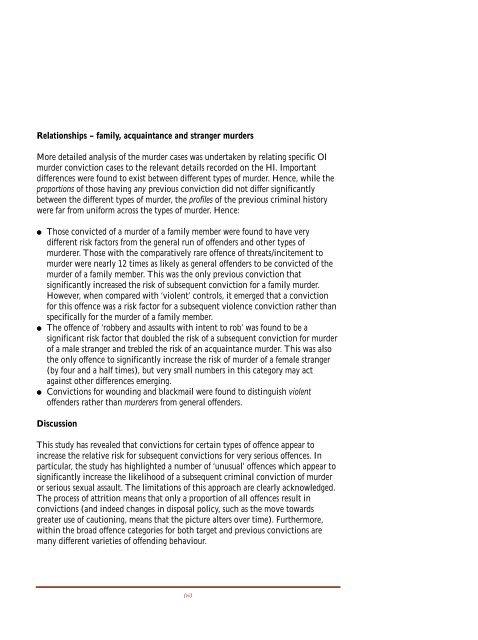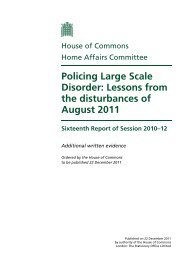Murder and Serious Sexual Assault - Lancaster EPrints - Lancaster ...
Murder and Serious Sexual Assault - Lancaster EPrints - Lancaster ...
Murder and Serious Sexual Assault - Lancaster EPrints - Lancaster ...
Create successful ePaper yourself
Turn your PDF publications into a flip-book with our unique Google optimized e-Paper software.
Relationships – family, acquaintance <strong>and</strong> stranger murders<br />
More detailed analysis of the murder cases was undertaken by relating specific OI<br />
murder conviction cases to the relevant details recorded on the HI. Important<br />
differences were found to exist between different types of murder. Hence, while the<br />
proportions of those having any previous conviction did not differ significantly<br />
between the different types of murder, the profiles of the previous criminal history<br />
were far from uniform across the types of murder. Hence:<br />
● Those convicted of a murder of a family member were found to have very<br />
different risk factors from the general run of offenders <strong>and</strong> other types of<br />
murderer. Those with the comparatively rare offence of threats/incitement to<br />
murder were nearly 12 times as likely as general offenders to be convicted of the<br />
murder of a family member. This was the only previous conviction that<br />
significantly increased the risk of subsequent conviction for a family murder.<br />
However, when compared with ‘violent’ controls, it emerged that a conviction<br />
for this offence was a risk factor for a subsequent violence conviction rather than<br />
specifically for the murder of a family member.<br />
● The offence of ‘robbery <strong>and</strong> assaults with intent to rob’ was found to be a<br />
significant risk factor that doubled the risk of a subsequent conviction for murder<br />
of a male stranger <strong>and</strong> trebled the risk of an acquaintance murder. This was also<br />
the only offence to significantly increase the risk of murder of a female stranger<br />
(by four <strong>and</strong> a half times), but very small numbers in this category may act<br />
against other differences emerging.<br />
● Convictions for wounding <strong>and</strong> blackmail were found to distinguish violent<br />
offenders rather than murderers from general offenders.<br />
Discussion<br />
This study has revealed that convictions for certain types of offence appear to<br />
increase the relative risk for subsequent convictions for very serious offences. In<br />
particular, the study has highlighted a number of ‘unusual’ offences which appear to<br />
significantly increase the likelihood of a subsequent criminal conviction of murder<br />
or serious sexual assault. The limitations of this approach are clearly acknowledged.<br />
The process of attrition means that only a proportion of all offences result in<br />
convictions (<strong>and</strong> indeed changes in disposal policy, such as the move towards<br />
greater use of cautioning, means that the picture alters over time). Furthermore,<br />
within the broad offence categories for both target <strong>and</strong> previous convictions are<br />
many different varieties of offending behaviour.<br />
(vii)
















